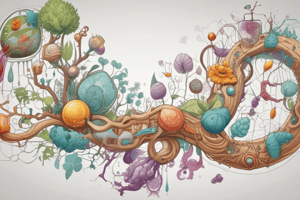Podcast
Questions and Answers
What is the scientific study of life and living organisms?
What is the scientific study of life and living organisms?
- Botany
- Genetics
- Ecology
- Biology (correct)
Which branch of biology studies the relationships between organisms and their environment?
Which branch of biology studies the relationships between organisms and their environment?
- Molecular Biology
- Ecology (correct)
- Zoology
- Microbiology
What is the basic unit of life?
What is the basic unit of life?
- Cell (correct)
- Molecule
- Tissue
- Organism
What is the function of the mitochondria in a cell?
What is the function of the mitochondria in a cell?
Who is credited with the theory of evolution by natural selection?
Who is credited with the theory of evolution by natural selection?
What is the term for the study of the structure and function of biological molecules?
What is the term for the study of the structure and function of biological molecules?
What is the function of the cell membrane?
What is the function of the cell membrane?
What is the term for the study of heredity, genes, and genetic variation?
What is the term for the study of heredity, genes, and genetic variation?
Flashcards are hidden until you start studying
Study Notes
Definition and Scope
- Biology is the scientific study of life and living organisms, including their structure, function, growth, evolution, distribution, and taxonomy.
- It explores the diversity of life, from molecules to ecosystems, and examines the interactions between living organisms and their environment.
Branches of Biology
- Botany: study of plants and their interactions with the environment
- Zoology: study of animals and their interactions with the environment
- Microbiology: study of microorganisms, such as bacteria and viruses
- Ecology: study of the relationships between organisms and their environment
- Genetics: study of heredity, genes, and genetic variation
- Biochemistry: study of the chemical processes that occur within living organisms
- Molecular Biology: study of the structure and function of biological molecules, such as DNA and proteins
Cell Biology
- Cells are the basic units of life, and all living organisms are composed of one or more cells.
- Cell membrane: surrounds the cell and regulates what enters and leaves
- Cytoplasm: jelly-like substance inside the cell membrane where metabolic reactions occur
- Nucleus: contains genetic material (DNA) and controls cell growth and reproduction
- Mitochondria: generate energy for the cell through cellular respiration
- Organelles: specialized structures within the cell that perform specific functions
Evolution
- Evolution is the change in the characteristics of a species over time through the process of natural selection.
- Charles Darwin's theory of evolution by natural selection states that organisms that are better adapted to their environment are more likely to survive and reproduce.
- Fossil record: provides evidence of evolutionary changes over time
- Comparative anatomy and embryology: provide evidence of evolutionary relationships between organisms
Ecosystems and Ecology
- Ecosystems: communities of living and non-living components (biotic and abiotic factors) that interact with each other.
- Biotic factors: living components, such as plants, animals, and microorganisms
- Abiotic factors: non-living components, such as light, temperature, and water
- Food chains and food webs: represent the flow of energy and nutrients through ecosystems
- Energy pyramid: shows the energy available at each trophic level in an ecosystem
Definition and Scope of Biology
- Biology is the scientific study of life and living organisms, covering structure, function, growth, evolution, distribution, and taxonomy.
- It explores the diversity of life, from molecules to ecosystems, and examines interactions between living organisms and their environment.
Branches of Biology
- Botany involves the study of plants and their interactions with the environment.
- Zoology involves the study of animals and their interactions with the environment.
- Microbiology involves the study of microorganisms, such as bacteria and viruses.
- Ecology involves the study of the relationships between organisms and their environment.
- Genetics involves the study of heredity, genes, and genetic variation.
- Biochemistry involves the study of the chemical processes that occur within living organisms.
- Molecular Biology involves the study of the structure and function of biological molecules, such as DNA and proteins.
Cell Biology
- Cells are the basic units of life, and all living organisms are composed of one or more cells.
- The cell membrane surrounds the cell and regulates what enters and leaves.
- Cytoplasm is the jelly-like substance inside the cell membrane where metabolic reactions occur.
- The nucleus contains genetic material (DNA) and controls cell growth and reproduction.
- Mitochondria generate energy for the cell through cellular respiration.
- Organelles are specialized structures within the cell that perform specific functions.
Evolution
- Evolution is the change in characteristics of a species over time through natural selection.
- Charles Darwin's theory of evolution by natural selection states that organisms better adapted to their environment are more likely to survive and reproduce.
- The fossil record provides evidence of evolutionary changes over time.
- Comparative anatomy and embryology provide evidence of evolutionary relationships between organisms.
Ecosystems and Ecology
- Ecosystems are communities of living and non-living components (biotic and abiotic factors) that interact with each other.
- Biotic factors include living components, such as plants, animals, and microorganisms.
- Abiotic factors include non-living components, such as light, temperature, and water.
- Food chains and food webs represent the flow of energy and nutrients through ecosystems.
- The energy pyramid shows the energy available at each trophic level in an ecosystem.
Studying That Suits You
Use AI to generate personalized quizzes and flashcards to suit your learning preferences.





